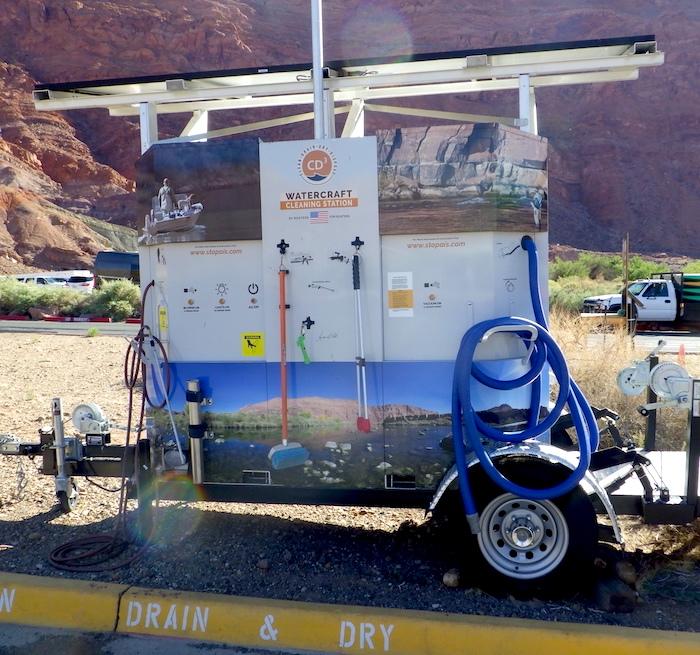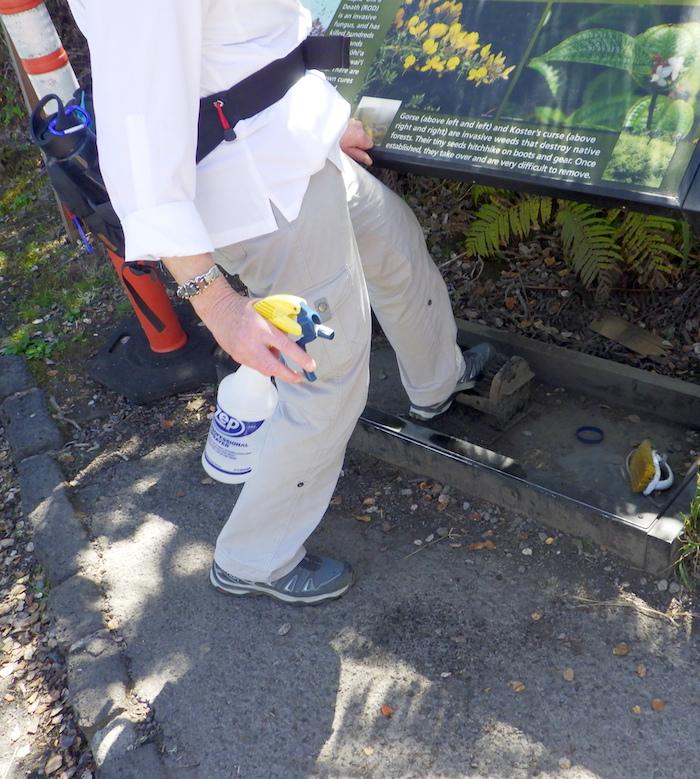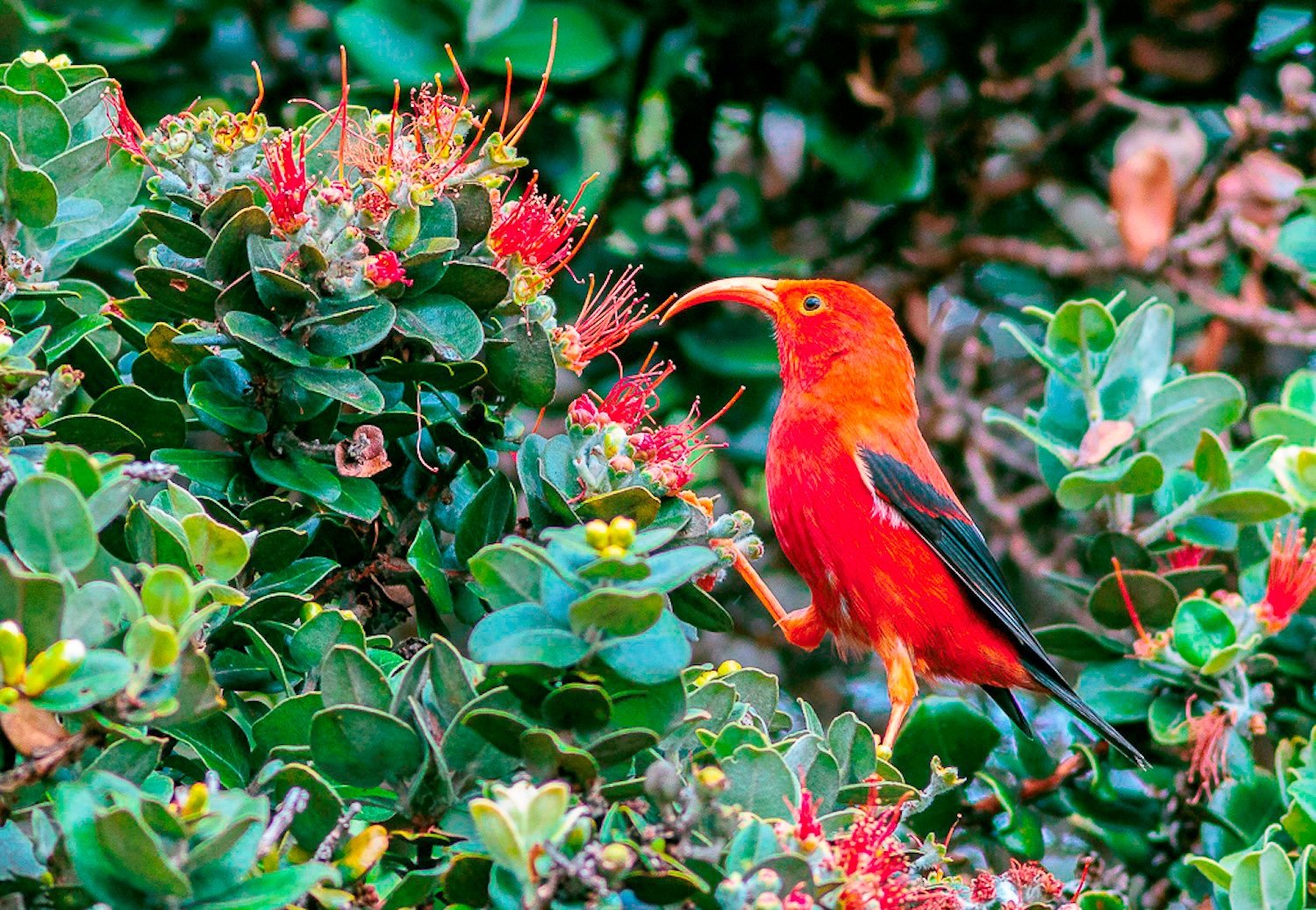With its sharp, hooked bill, the kiwikiu is a master at cracking open branches or berries in pursuit of a plump insect meal. Ironically, this olive green and yellow bird, already on the national endangered species list, risks being pushed into extinction by an insect not originally native to the Hawaiian islands.
The Hawaiian islands once counted more than 50 species of endemic forest birds, but today there are fewer than 17 species, according to the National Park Service, some with fewer than 500 individuals left.
The kiwikiu, a variety of honeycreeper also known as the Maui Parrotbill, is one of the dwindling species and is predicted to vanish from the Earth in just six years. Once abundant across Maui and Moloka'i, today fewer than 200 individuals are believed to be found across less than 8,000 acres on Maui in Haleakalā National Park, Hanawi Natural Area Reserve, and The Nature Conservancy’s Waikamoi Preserve.
A developing bid to save the species from extinction is just one example of how National Park Service staff is turning to technologies and innovative strategies for combatting invasive species that threaten to upend ecosystems, and their native inhabitants, in the National Park System.

An adult Maui parrotbill/Alan Liberman, Keauhou Bird Conservation Center via USFWS
The kiwikiu's decline has been driven by loss of habitat to the encroaching human footprint, natural predators, and even feral cats. Today, though, the invasive Culex mosquito poses perhaps the greatest threat, for these insects can not only reach the kiwikiu in the highest koa branches, but they are moving higher and higher in the mountains on the island, following this honeycreeper species. And when bugs poke the birds for a quick meal, they can leave behind a deadly dose of avian malaria.
"Most of Hawaii's honeycreepers, which is, and was, the most diverse group of native birds, they're immunologically naive to avian malaria, which is a really common disease throughout the world," said Chris Warren, a forest bird biologist at Haleakalā. "And it's usually more of a, you know, they suffer from it a little while, and then they recover. So that certainly would put birds at threat of not getting to eat or not being able to care for their young. But here with these birds, they just simply drop dead.
"And that has put them at a significant disadvantage, because we also have a lot of the same invasive issues that other places do," Warren continued. "You know, certainly other islands have got invasive mammals that just eat them. We've got invasive ungulates that eat their habitat, sometimes for generations. And then you add on avian malaria."
Compounding the problem of avian malaria is climate change, as warming temperatures in Hawaii are allowing the mosquitoes to range higher and higher, and at Haleakalā that means being able to follow honeycreepers higher into the mountains.
Invasive Problems Across The Parks
While the problem with avian malaria might be unique to the endemic birds at Haleakalā compared to other units of the National Park System, problems with invasive plant and animal species are not. Many parks in the continental Southwest have stretches of invasive tamarisk and Russian olive trees that crowd out the natives. Quagga and zebra mussels have become a problem across much of the country. Feral hogs are rooting through Great Smoky Mountains National Park in Tennessee and North Carolina, Big Thicket National Preserve in Texas, and Pinnacles National Park in California, just to name three locations. Feral burros exist at Grand Canyon National Park, Death Valley, and even Virgin Islands National Park.
The list goes on, from lionfish at Dry Tortugas and Biscayne national parks in Florida, to lake trout in Yellowstone in Wyoming and cattails at Voyageurs in Minnesota.
Many of the battles against these invaders are waged with sweat and muscle. Crews head into the parks with machetes and handsaws to cut down invasive vegetation, cast nets to capture non-native fish, or climb over, and under, boats in a search for invasive mussels. At Glen Canyon National Recreation Area in Utah and Arizona, a bounty was placed on brown trout in a bid to encourage anglers to focus on that invader.
"There's chainsaws running, cutting out the [Brazilian] pepper. Sometimes we're completely removing it, mulching it, chipping it," said Chris White, a project ecologist with Cardno, a global engineering and environmental consulting firm that has worked with the National Park Service on some invasive problems, in discussing the hard work of physically removing invasive vegetation. "Otherwise, we're spraying it with spray rigs. The spray rigs could be, generally if it's pepper, it's from a UTV, something on land, not as much access from water."
Once the initial work is done, though, there often needs to be a routine of ongoing maintenance, at least for a few years. "With all of these you want some sort of maintenance plan," White said. "Preferably, you want to be able to have some sort of maintenance plan in place, so that you could come back with backpacks or UTV or something and foliar spray all the teeny little baby re-sprouts."
Without eradication, the invasive vegetation can upend an ecosystem, he said.

The National Park Service in some parks uses solar-powered boat decontamination stations to battle quagga and zebra mussels/Kurt Repanshek
The non-native vegetation "decreases biodiversity, less species are using it," White said. "Things do use it, but you're decreasing the number of species that use it for habitat. It creates a monoculture, so then it's not creating as much biodiversity for everything else."
Innovations Against Invasives
Varying levels of technology and innovative approaches are being turned to in the battles. At Great Smoky Mountains, for example, remotely triggered trapdoors on pens are sprung to capture hogs. At Yellowstone, tracking devices have been embedded in lake trout so fisheries biologists can find and destroy their spawning beds. Water sampling also can be done to detect the DNA of a non-native fish or mollusk.
Hawai'i Volcanoes National Park relies on a device as simple as a boot-brushing station, complete with spray bottle, that can be found at many trailheads, with hikers asked to clean the soles of their shoes before, and even after, a hike. At Glen Canyon, a solar-powered boat-decontamination station at Lees Ferry is available for boaters to use in a bid to halt the spread of quagga and zebra mussels.
The U.S. Geological Survey has even come up with software that models where on a landscape invasive plants might encroach.
But the evolution of technologies likely will accelerate, for the current battles against invasives are piecemeal and largely seen as losing the overall war.
"Control costs climb as new invasive species establish and existing invaders spread and reproduce. Parks, for their part, are doing the best they can with the fiscal and operational resources, information, and leveraged partnerships available," noted Biodiversity Under Siege, Invasive Animals and the National Park Service, a 2018 report prepared by the agency. "But parks are losing the battle, and this ultimately erodes the NPS mission."
Gene-manipulation is almost certain to enter the battle as other efforts fail to control, or remove, invasives from the park system.
"I do think that genetic approaches are something that will ultimately get discussed because it's something that's getting discussed in the broad context of invasive species," said John Wullschleger, a fisheries expert in the National Park Service Water Resources Division. "I don't know if it would be a cancer [inducing]-type thing, but I think one of the things that's come up -- not specifically with respect to zebra [or quagga] mussels, nobody's that far down that road -- but I know they've talked about things like gene drive, and things like that, where you introduce a lethal gene into a population, and then basically set it loose and the species essentially goes to extinction."

Boot-cleaning stations at trailheads in Hawai'i Volcanoes National Park help slow the spread of invasive weeds/Kurt Repanshek
At Everglades National Park, pheromones are being tested for use against Burmese pythons, according to Ruscena Wiederholt, Ph.D, a quantative ecologist at the Everglades Foundation.
The snakes are thought to have reached the park through pet owners who released them after they became too large to be considered pets. Today there are thought to be tens of thousands of pythons in Everglades and neighboring Big Cypress National Preserve. The hope is that pheromones from female snakes could lead male pythons into traps, Wiederholt said.
"The've also put trackers on different snakes so it helps them learn more about their biology and where they're going," she said. " They're called 'Judas snakes' because once they're tagged they can lead them to other snakes."
While the battle with pythons continues, the snakes are feasting on small mammals like racoons, foxes, and even white-tailed deer. According to a 2011 study, the snakes seem to be behind a 99 percent drop in racoon sightings in the Everglades, a nearly 99 percent drop in opossum sightings, and an 87.5 percent drop in bobcat sightings. Rabbits seemed to have completely vanished from sight, the study added.
A Tiny Air Force
Back at Haleakalā, a tiny air force is being counted on to prevent a wave of avian malaria from devastating not just the kiwikiu, but also the ʻākohekohe, another honeycreeper variety that is listed as endangered with fewer than 1,800 left in the world, and the ʻiʻiwi, a spectacularly colored honeycreeper (top photo) listed as threatened.
"There's a multi-pronged threat going on, where their habitat is limited, they've got all these predators out to get them. But they're able to hang on in these higher elevations, and now we are seeing mosquitoes and malaria at higher and higher elevations, up to the tree-line, in many cases," Warren said. "So, if you collect a blood sample from a bird, even at like 7,000 feet, you can see a positive. And it's hard to get a sense of how much has changed. But we know things are changing very quickly. We are seeing populations of birds vanish in just a few years. ... the mosquitoes are bringing malaria all the way up the top of the mountain. And we have to do something about it right now. We'll lose the bird," he said.
The approach the park hopes to implement is to release male Culex mosquitoes that carry a naturally occurring bacteria, Wolbachia, that differs from the Wolbachia strain females carry and so upend the female's reproduction.
"The bacteria has kind of hijacked the reproductive system of the mosquitoes," explained Warren. "If one mosquito that has a type one Wolbachia tries to breed with another mosquito that has a different type, Wolbachia type two, none of those offspring survive. They lay eggs, but the embryos die."
This approach has been used successfully in many parts of the world, said the biologist, though most of those applications have been to address human illness transmitted by mosquitoes.
"One of our biggest challenges is going to be applying it in our wilderness setting," said Warren. "We know that the technique will work in terms of the biology of the mosquitoes. I think a big challenge is going to be how we do this on a really large and very remote landscapes."
The Park Service currently is preparing an environmental assessment outlining the approach. If things proceed on schedule, a decision to move forward could be made this fall.
"We are working on this like our hair's on fire," the biologist said. "We are hoping that we can just scale up bigger and bigger over time to really control the mosquito population. I think that's where we can feel successful if we are controlling it. I can't see how it really can be eradicated."
Previous installments in this series:
Traveler Special Report: The Invasion Of The National Park System
Traveler Special Report: Invasive Fish in National Parks
Audio Postcard From The Parks | Battling Russian Olive At Glen Canyon NRA
Traveler Special Report: Vegetative Invaders In The National Parks
Charitable Dollars Help In Fight Against Invasives In National Park System
Traveler Special Report: The Cost Of Invasive Species In The National Park System
Traveler Special Report: Battling Invaders With Fire At National Battlefields
Traveler Special Report: Measuring Successes Against Invasive Species
Traveler's Audio Postcards From The Parks: Hog Wild
Traveler Special Report: Invasive Mammals And The National Parks





 Support Essential Coverage of Essential Places
Support Essential Coverage of Essential Places







Add comment